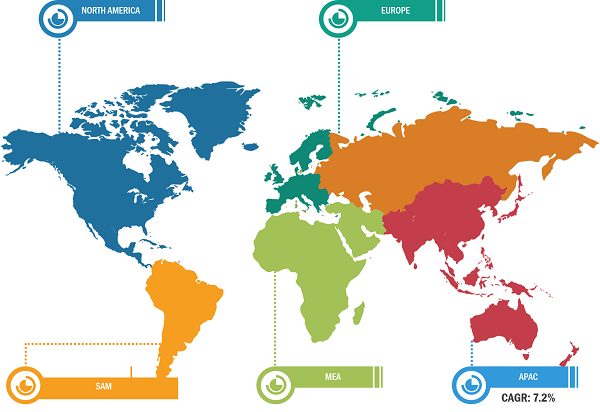
Workwear Market
Asia Pacific is expected to register the fastest CAGR in the workwear market during the forecast period. Increasing cases of occupational injuries, an increase in the number of surgeries and occupational deaths, high demand for safety apparel, growing expenditure on work safety by end users, such as oil and gas, food, automotive, and the presence of major market players, are some of the prominent factors propelling the workwear market growth in North America. In addition, stringent government regulations in the region regarding the safety of working professionals in factories and on-site workers, coupled with penalties for non-compliance with the standards, augmented the adoption of workwear. The rise in demand for industrial workwear, mainly from oil & gas, chemical, construction, healthcare, and other industries, is fueling the workwear market growth in the region.
Increasing Demand from Emerging Economies Propel Workwear Market Growth During Forecast Period
The growth of the workwear market is directly influenced by the increasing demand from emerging economies across the globe. Emerging economies, such as China, India, Indonesia, and Malaysia, are experiencing rapid development in various industrial sectors such as construction, chemicals, healthcare, and mining. Governments of these emerging economies are increasing their focus on infrastructure development. For instance, in November 2021, India, the US, Israel, and the UAE established a new quadrilateral economic forum to focus on infrastructure development projects and strengthen bilateral cooperation. Such government initiatives will likely fuel the demand for workwear in the region over the next few years.

Further, the rise in infrastructure projects in developing countries, such as Tuban Olefin Complex Development Project (Indonesia), Singapore Deep Tunnel Sewerage System, and Shenzhong Link (China), are further fueling the demand for workwear to ensure workers’ safety. Such demand from emerging economies is expected to open immense growth avenues for the workwear market players during the forecast period.
Workwear Market: Segmental Overview
Based on product type, the workwear market is segmented into topwear, bottomwear, and coveralls. The topwear segment held the largest share of the market in 2020. The growth of the corporate sector is a major driving factor for the topwear segment as internal policies allow an employer to set dress codes that the employees are required to follow. Moreover, the growing awareness of employee safety in all end-use industries has increased the demand for topwear. In the healthcare industry, nurses, doctors, and other staff usually come in contact with many bodily fluids and disease-causing germs. The use of antibacterial aprons and scrubs can protect healthcare staff and patients. Hence, such antibacterial, stain-free topwear has high demand in the healthcare sector.
Based on category, the workwear market is segmented into men, women, and unisex. The women segment is expected to register the highest CAGR during the forecast period. Workwear has become essential to people’s lifestyles, particularly for women. Strong growth of the corporate sector across the globe and work safety awareness, combined with a rise in occupational injuries, are increasing the demand for workwear among women. The growing number of working women population is aiding the workwear market growth in the women segment.
Based on end use, the workwear market is segmented into construction, oil and gas, healthcare, chemicals, and others. The healthcare segment is expected to register the highest CAGR during the forecast period. The healthcare industry is one of the prominent end users of workwear. According to the 2021 report of the WHO, approximately 27 million men and women comprise the global nursing and midwifery workforce. There is a global shortage of workforce in the healthcare industry. Many healthcare centers are offering job opportunities. Hence, the rising need for a workforce in the healthcare sector, followed by recruitment, is projected to surge the demand for workwear.
Based on distribution channel, the workwear market is segmented into wholesalers, supermarkets and hypermarkets, specialty stores, and online platforms. The online platforms segment is expected to register the highest CAGR during the forecast period. Online portals such as Amazon and eBay have promoted the growth of the workwear market as online retailing reduces the operation cost of manufacturers and allows them to reach targeted customers across the globe. Many workwear brands have their own online platform for distribution of their wide range of products. Further, online retail has added benefits of home delivery, varied payment options, and attractive discounts and offers for customers.
Impact of COVID-19 Pandemic on Workwear Market
The COVID-19 pandemic affected economies and industries in various countries due to lockdowns, travel bans, and business shutdowns. Several industries, including oil & gas, construction, chemicals, and mining, suffered serious disruptions, such as breaks in supply chains and shutdowns of production plants. The shutdown of manufacturing units caused disturbances in global supply chains, manufacturing activities, delivery schedules, and essential and nonessential product sales. Various companies witnessed delays in product deliveries and a slump in sales of their products in 2020.
Moreover, governments in Europe, Asia Pacific, and North America imposed bans on international travel, which temporarily compelled companies to discontinue their collaboration and partnership plans. However, all these factors hampered various industries in 2020 and early 2021, restraining the growth of various markets, including the workwear market. On the other hand, the COVID-19 outbreak positively affected the workwear market in the healthcare sector. The pandemic created a significant demand for healthcare PPE products such as gloves, gowns, coveralls, face shields, masks, and goggles.
Workwear Market: Competitive Landscape
Carhartt, Inc., Aramark, Alisco Group, Alexandra, 3M, A. LAFONT SAS, Fristads Kansas Group, Hultafors Group, Lakeland Industries, Inc. are among the major players operating in the workwear market. Companies in this market emphasize strategies such as R&D investments and new product launches. Such strategic initiatives by key market players boost the demand for workwear and drive the market.







